Organization Leadership: Change Management, Styles, and Intelligence
VerifiedAdded on 2023/05/30
|21
|6289
|441
Essay
AI Summary
This essay examines the pivotal role of leadership within organizations, emphasizing its influence on success and failure. It delves into the distinction between leaders and managers, highlighting the importance of employee development and goal orientation. The essay then focuses on healthcare, exploring how leadership catalyzes the functioning of key building blocks, such as health service delivery and health workforce. It identifies change management, leadership styles, and emotional intelligence as crucial concepts for achieving desired outcomes in healthcare. The essay explores the complexities of change management, including resistance and the application of change management models like Lewin's 3-step model. It also touches upon the emergent change model and the impact of leadership on successful transitions. By understanding these concepts, healthcare leaders can navigate change, foster effective leadership styles, and utilize emotional intelligence to improve healthcare outcomes.
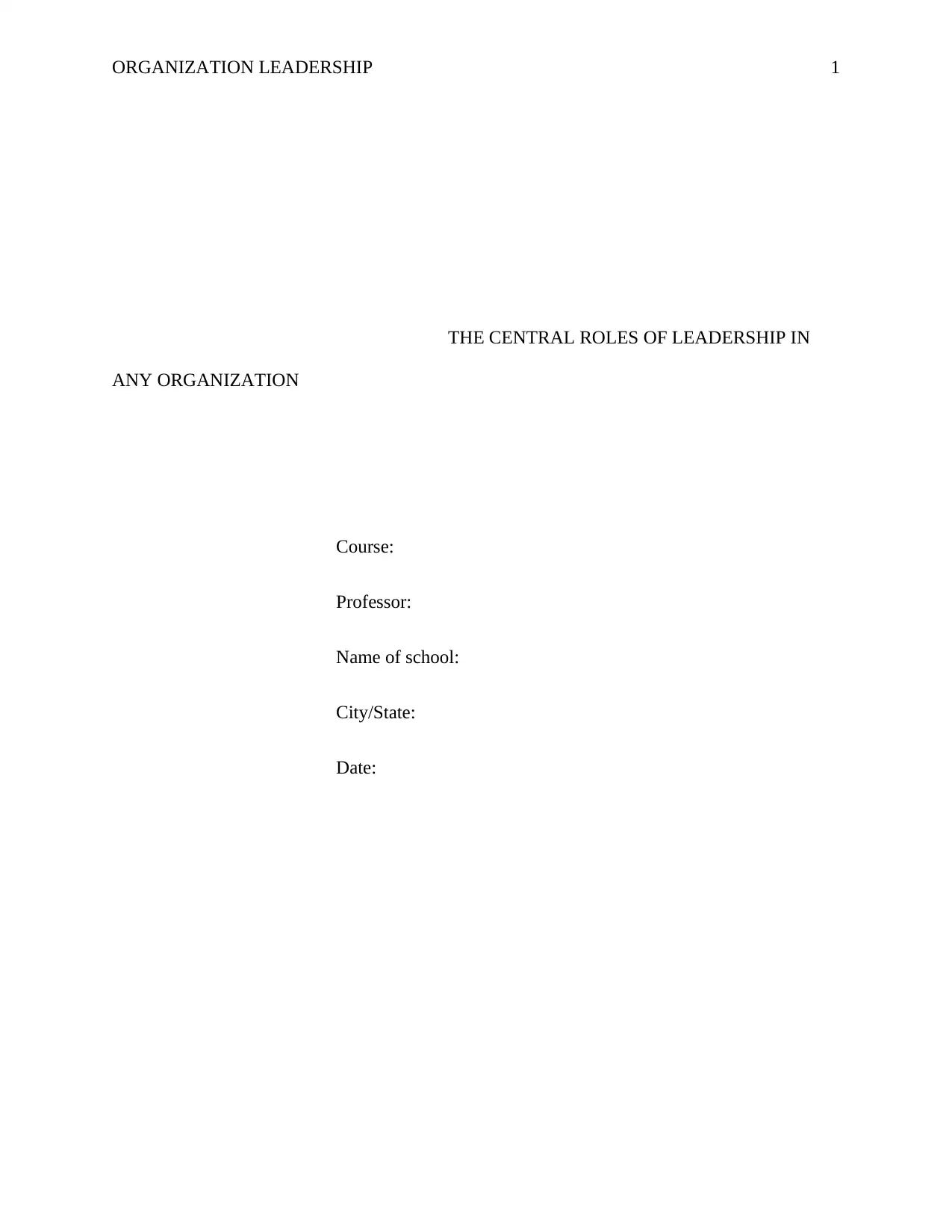
ORGANIZATION LEADERSHIP 1
THE CENTRAL ROLES OF LEADERSHIP IN
ANY ORGANIZATION
Course:
Professor:
Name of school:
City/State:
Date:
THE CENTRAL ROLES OF LEADERSHIP IN
ANY ORGANIZATION
Course:
Professor:
Name of school:
City/State:
Date:
Paraphrase This Document
Need a fresh take? Get an instant paraphrase of this document with our AI Paraphraser
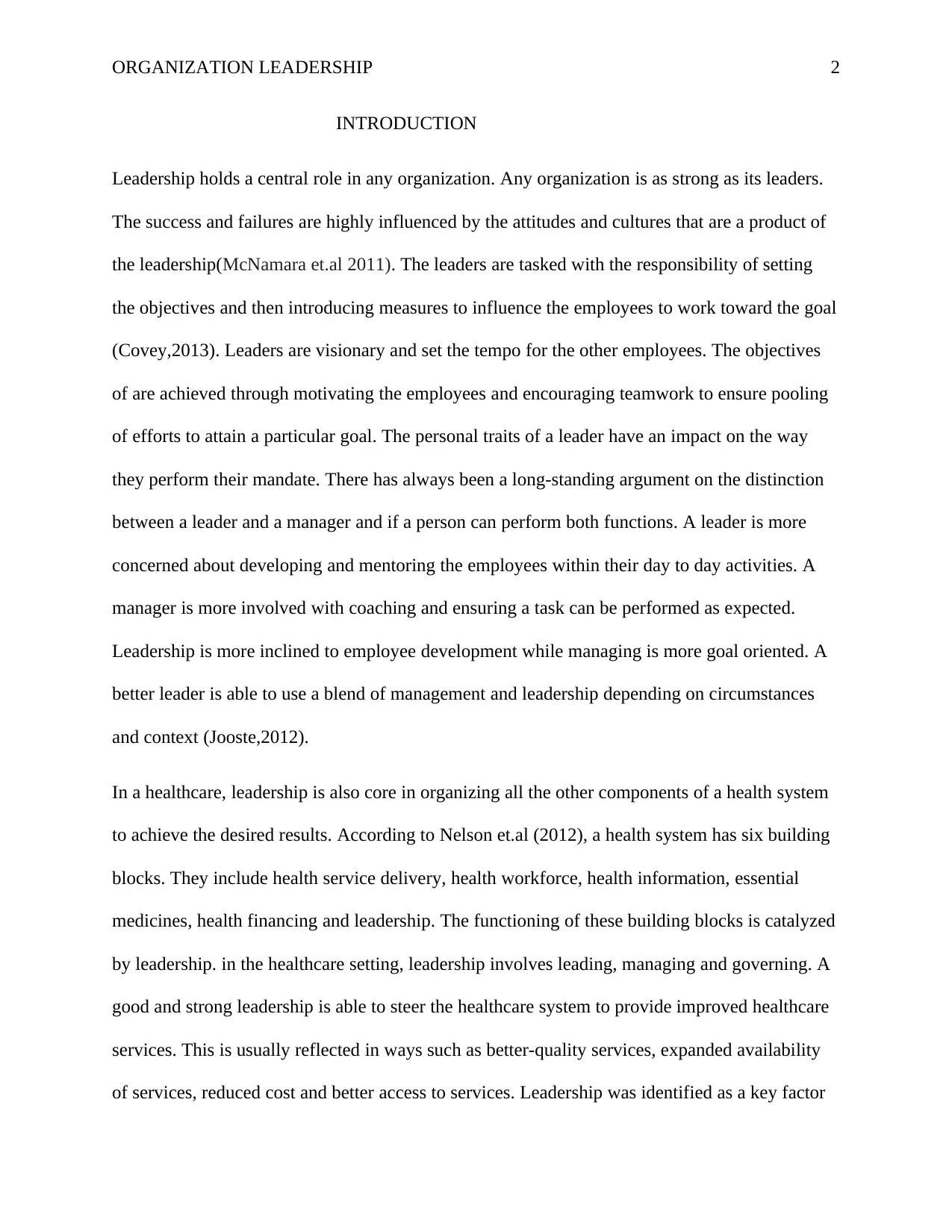
ORGANIZATION LEADERSHIP 2
INTRODUCTION
Leadership holds a central role in any organization. Any organization is as strong as its leaders.
The success and failures are highly influenced by the attitudes and cultures that are a product of
the leadership(McNamara et.al 2011). The leaders are tasked with the responsibility of setting
the objectives and then introducing measures to influence the employees to work toward the goal
(Covey,2013). Leaders are visionary and set the tempo for the other employees. The objectives
of are achieved through motivating the employees and encouraging teamwork to ensure pooling
of efforts to attain a particular goal. The personal traits of a leader have an impact on the way
they perform their mandate. There has always been a long-standing argument on the distinction
between a leader and a manager and if a person can perform both functions. A leader is more
concerned about developing and mentoring the employees within their day to day activities. A
manager is more involved with coaching and ensuring a task can be performed as expected.
Leadership is more inclined to employee development while managing is more goal oriented. A
better leader is able to use a blend of management and leadership depending on circumstances
and context (Jooste,2012).
In a healthcare, leadership is also core in organizing all the other components of a health system
to achieve the desired results. According to Nelson et.al (2012), a health system has six building
blocks. They include health service delivery, health workforce, health information, essential
medicines, health financing and leadership. The functioning of these building blocks is catalyzed
by leadership. in the healthcare setting, leadership involves leading, managing and governing. A
good and strong leadership is able to steer the healthcare system to provide improved healthcare
services. This is usually reflected in ways such as better-quality services, expanded availability
of services, reduced cost and better access to services. Leadership was identified as a key factor
INTRODUCTION
Leadership holds a central role in any organization. Any organization is as strong as its leaders.
The success and failures are highly influenced by the attitudes and cultures that are a product of
the leadership(McNamara et.al 2011). The leaders are tasked with the responsibility of setting
the objectives and then introducing measures to influence the employees to work toward the goal
(Covey,2013). Leaders are visionary and set the tempo for the other employees. The objectives
of are achieved through motivating the employees and encouraging teamwork to ensure pooling
of efforts to attain a particular goal. The personal traits of a leader have an impact on the way
they perform their mandate. There has always been a long-standing argument on the distinction
between a leader and a manager and if a person can perform both functions. A leader is more
concerned about developing and mentoring the employees within their day to day activities. A
manager is more involved with coaching and ensuring a task can be performed as expected.
Leadership is more inclined to employee development while managing is more goal oriented. A
better leader is able to use a blend of management and leadership depending on circumstances
and context (Jooste,2012).
In a healthcare, leadership is also core in organizing all the other components of a health system
to achieve the desired results. According to Nelson et.al (2012), a health system has six building
blocks. They include health service delivery, health workforce, health information, essential
medicines, health financing and leadership. The functioning of these building blocks is catalyzed
by leadership. in the healthcare setting, leadership involves leading, managing and governing. A
good and strong leadership is able to steer the healthcare system to provide improved healthcare
services. This is usually reflected in ways such as better-quality services, expanded availability
of services, reduced cost and better access to services. Leadership was identified as a key factor
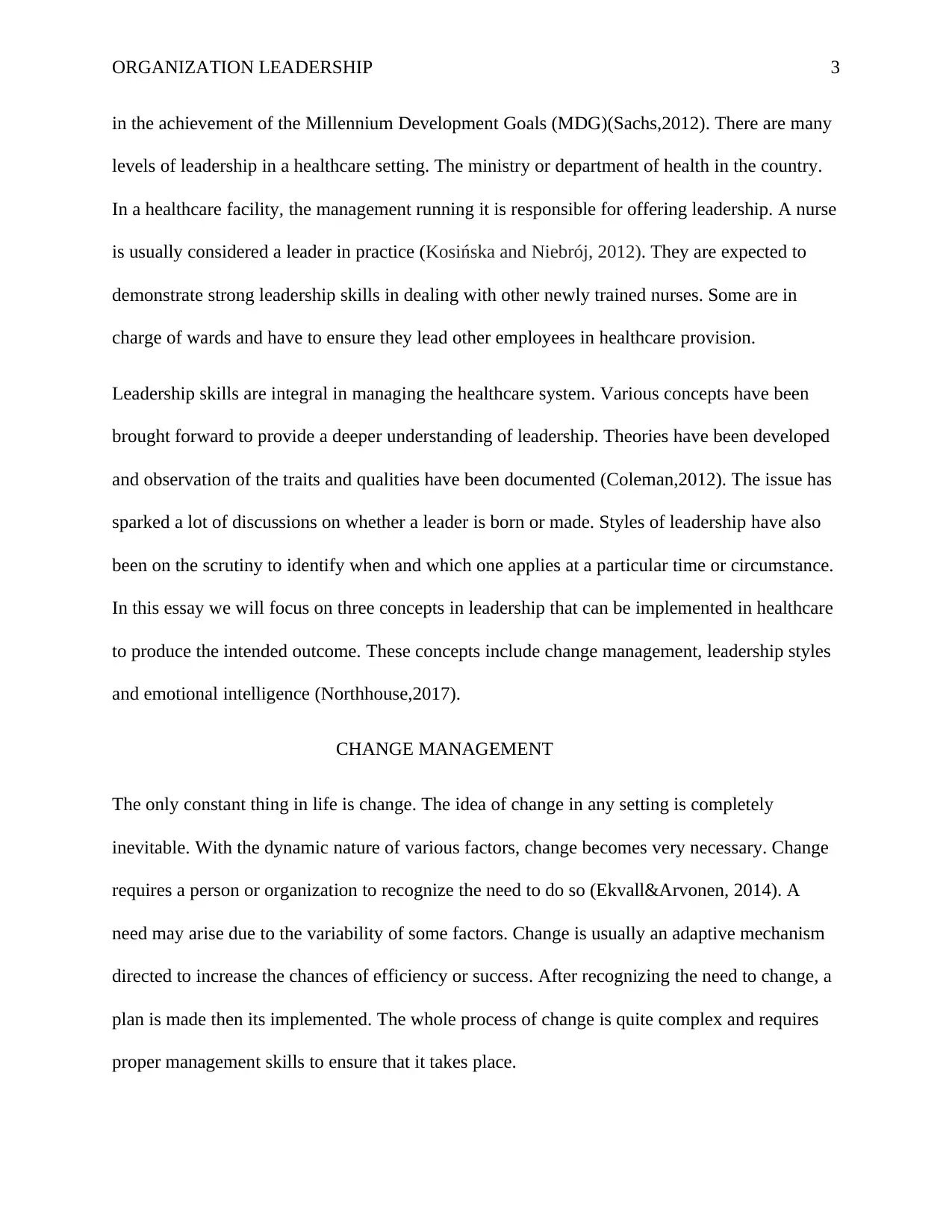
ORGANIZATION LEADERSHIP 3
in the achievement of the Millennium Development Goals (MDG)(Sachs,2012). There are many
levels of leadership in a healthcare setting. The ministry or department of health in the country.
In a healthcare facility, the management running it is responsible for offering leadership. A nurse
is usually considered a leader in practice (Kosińska and Niebrój, 2012). They are expected to
demonstrate strong leadership skills in dealing with other newly trained nurses. Some are in
charge of wards and have to ensure they lead other employees in healthcare provision.
Leadership skills are integral in managing the healthcare system. Various concepts have been
brought forward to provide a deeper understanding of leadership. Theories have been developed
and observation of the traits and qualities have been documented (Coleman,2012). The issue has
sparked a lot of discussions on whether a leader is born or made. Styles of leadership have also
been on the scrutiny to identify when and which one applies at a particular time or circumstance.
In this essay we will focus on three concepts in leadership that can be implemented in healthcare
to produce the intended outcome. These concepts include change management, leadership styles
and emotional intelligence (Northhouse,2017).
CHANGE MANAGEMENT
The only constant thing in life is change. The idea of change in any setting is completely
inevitable. With the dynamic nature of various factors, change becomes very necessary. Change
requires a person or organization to recognize the need to do so (Ekvall&Arvonen, 2014). A
need may arise due to the variability of some factors. Change is usually an adaptive mechanism
directed to increase the chances of efficiency or success. After recognizing the need to change, a
plan is made then its implemented. The whole process of change is quite complex and requires
proper management skills to ensure that it takes place.
in the achievement of the Millennium Development Goals (MDG)(Sachs,2012). There are many
levels of leadership in a healthcare setting. The ministry or department of health in the country.
In a healthcare facility, the management running it is responsible for offering leadership. A nurse
is usually considered a leader in practice (Kosińska and Niebrój, 2012). They are expected to
demonstrate strong leadership skills in dealing with other newly trained nurses. Some are in
charge of wards and have to ensure they lead other employees in healthcare provision.
Leadership skills are integral in managing the healthcare system. Various concepts have been
brought forward to provide a deeper understanding of leadership. Theories have been developed
and observation of the traits and qualities have been documented (Coleman,2012). The issue has
sparked a lot of discussions on whether a leader is born or made. Styles of leadership have also
been on the scrutiny to identify when and which one applies at a particular time or circumstance.
In this essay we will focus on three concepts in leadership that can be implemented in healthcare
to produce the intended outcome. These concepts include change management, leadership styles
and emotional intelligence (Northhouse,2017).
CHANGE MANAGEMENT
The only constant thing in life is change. The idea of change in any setting is completely
inevitable. With the dynamic nature of various factors, change becomes very necessary. Change
requires a person or organization to recognize the need to do so (Ekvall&Arvonen, 2014). A
need may arise due to the variability of some factors. Change is usually an adaptive mechanism
directed to increase the chances of efficiency or success. After recognizing the need to change, a
plan is made then its implemented. The whole process of change is quite complex and requires
proper management skills to ensure that it takes place.
⊘ This is a preview!⊘
Do you want full access?
Subscribe today to unlock all pages.

Trusted by 1+ million students worldwide
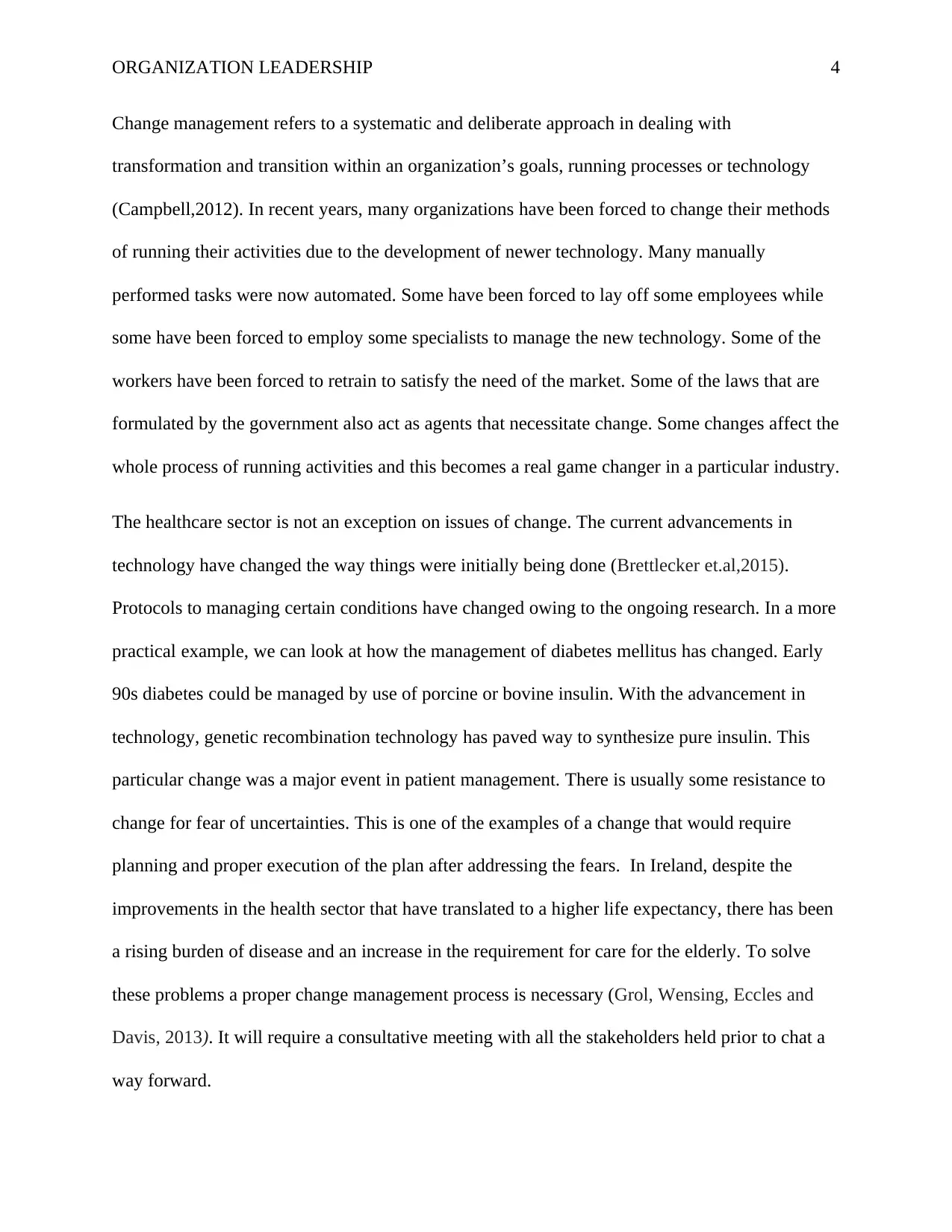
ORGANIZATION LEADERSHIP 4
Change management refers to a systematic and deliberate approach in dealing with
transformation and transition within an organization’s goals, running processes or technology
(Campbell,2012). In recent years, many organizations have been forced to change their methods
of running their activities due to the development of newer technology. Many manually
performed tasks were now automated. Some have been forced to lay off some employees while
some have been forced to employ some specialists to manage the new technology. Some of the
workers have been forced to retrain to satisfy the need of the market. Some of the laws that are
formulated by the government also act as agents that necessitate change. Some changes affect the
whole process of running activities and this becomes a real game changer in a particular industry.
The healthcare sector is not an exception on issues of change. The current advancements in
technology have changed the way things were initially being done (Brettlecker et.al,2015).
Protocols to managing certain conditions have changed owing to the ongoing research. In a more
practical example, we can look at how the management of diabetes mellitus has changed. Early
90s diabetes could be managed by use of porcine or bovine insulin. With the advancement in
technology, genetic recombination technology has paved way to synthesize pure insulin. This
particular change was a major event in patient management. There is usually some resistance to
change for fear of uncertainties. This is one of the examples of a change that would require
planning and proper execution of the plan after addressing the fears. In Ireland, despite the
improvements in the health sector that have translated to a higher life expectancy, there has been
a rising burden of disease and an increase in the requirement for care for the elderly. To solve
these problems a proper change management process is necessary (Grol, Wensing, Eccles and
Davis, 2013). It will require a consultative meeting with all the stakeholders held prior to chat a
way forward.
Change management refers to a systematic and deliberate approach in dealing with
transformation and transition within an organization’s goals, running processes or technology
(Campbell,2012). In recent years, many organizations have been forced to change their methods
of running their activities due to the development of newer technology. Many manually
performed tasks were now automated. Some have been forced to lay off some employees while
some have been forced to employ some specialists to manage the new technology. Some of the
workers have been forced to retrain to satisfy the need of the market. Some of the laws that are
formulated by the government also act as agents that necessitate change. Some changes affect the
whole process of running activities and this becomes a real game changer in a particular industry.
The healthcare sector is not an exception on issues of change. The current advancements in
technology have changed the way things were initially being done (Brettlecker et.al,2015).
Protocols to managing certain conditions have changed owing to the ongoing research. In a more
practical example, we can look at how the management of diabetes mellitus has changed. Early
90s diabetes could be managed by use of porcine or bovine insulin. With the advancement in
technology, genetic recombination technology has paved way to synthesize pure insulin. This
particular change was a major event in patient management. There is usually some resistance to
change for fear of uncertainties. This is one of the examples of a change that would require
planning and proper execution of the plan after addressing the fears. In Ireland, despite the
improvements in the health sector that have translated to a higher life expectancy, there has been
a rising burden of disease and an increase in the requirement for care for the elderly. To solve
these problems a proper change management process is necessary (Grol, Wensing, Eccles and
Davis, 2013). It will require a consultative meeting with all the stakeholders held prior to chat a
way forward.
Paraphrase This Document
Need a fresh take? Get an instant paraphrase of this document with our AI Paraphraser
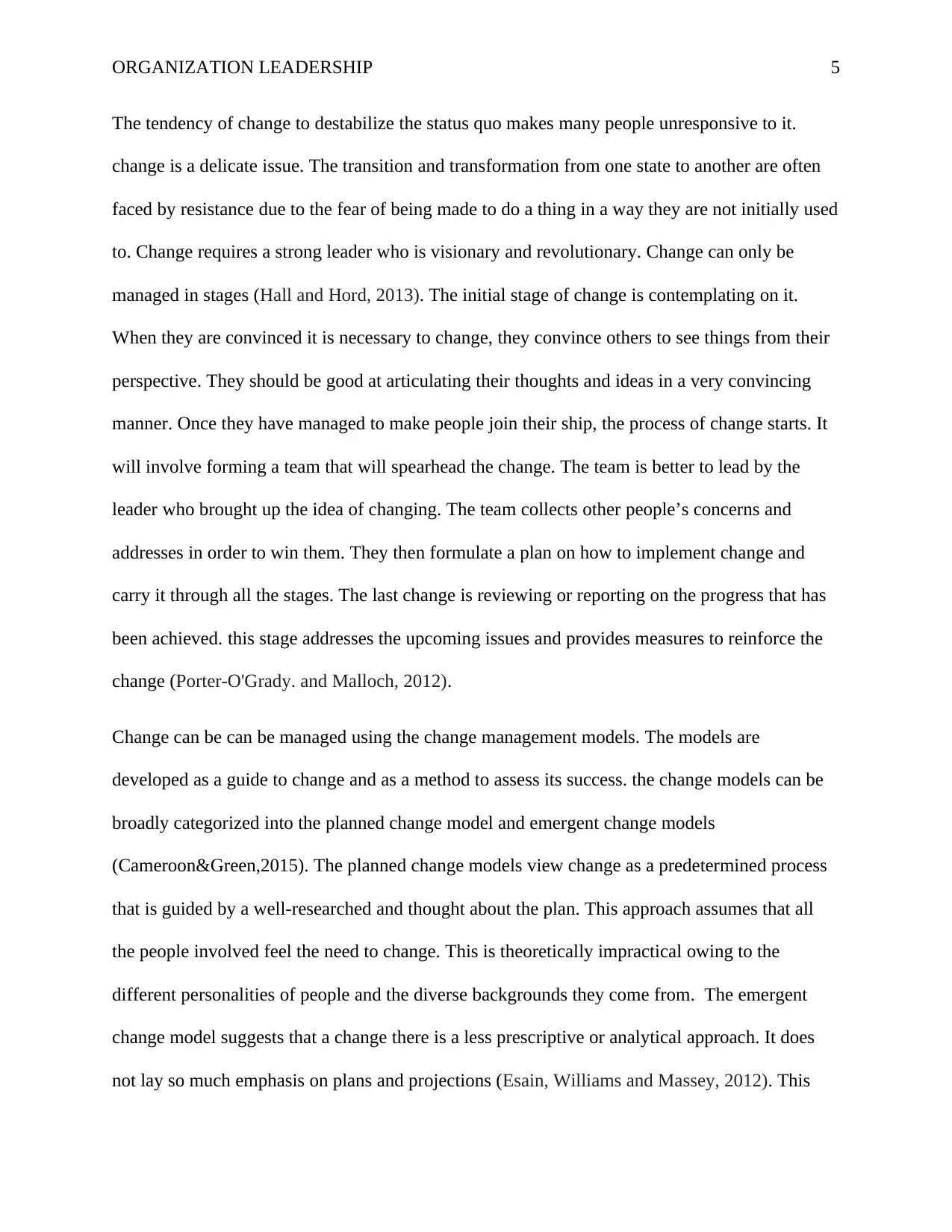
ORGANIZATION LEADERSHIP 5
The tendency of change to destabilize the status quo makes many people unresponsive to it.
change is a delicate issue. The transition and transformation from one state to another are often
faced by resistance due to the fear of being made to do a thing in a way they are not initially used
to. Change requires a strong leader who is visionary and revolutionary. Change can only be
managed in stages (Hall and Hord, 2013). The initial stage of change is contemplating on it.
When they are convinced it is necessary to change, they convince others to see things from their
perspective. They should be good at articulating their thoughts and ideas in a very convincing
manner. Once they have managed to make people join their ship, the process of change starts. It
will involve forming a team that will spearhead the change. The team is better to lead by the
leader who brought up the idea of changing. The team collects other people’s concerns and
addresses in order to win them. They then formulate a plan on how to implement change and
carry it through all the stages. The last change is reviewing or reporting on the progress that has
been achieved. this stage addresses the upcoming issues and provides measures to reinforce the
change (Porter-O'Grady. and Malloch, 2012).
Change can be can be managed using the change management models. The models are
developed as a guide to change and as a method to assess its success. the change models can be
broadly categorized into the planned change model and emergent change models
(Cameroon&Green,2015). The planned change models view change as a predetermined process
that is guided by a well-researched and thought about the plan. This approach assumes that all
the people involved feel the need to change. This is theoretically impractical owing to the
different personalities of people and the diverse backgrounds they come from. The emergent
change model suggests that a change there is a less prescriptive or analytical approach. It does
not lay so much emphasis on plans and projections (Esain, Williams and Massey, 2012). This
The tendency of change to destabilize the status quo makes many people unresponsive to it.
change is a delicate issue. The transition and transformation from one state to another are often
faced by resistance due to the fear of being made to do a thing in a way they are not initially used
to. Change requires a strong leader who is visionary and revolutionary. Change can only be
managed in stages (Hall and Hord, 2013). The initial stage of change is contemplating on it.
When they are convinced it is necessary to change, they convince others to see things from their
perspective. They should be good at articulating their thoughts and ideas in a very convincing
manner. Once they have managed to make people join their ship, the process of change starts. It
will involve forming a team that will spearhead the change. The team is better to lead by the
leader who brought up the idea of changing. The team collects other people’s concerns and
addresses in order to win them. They then formulate a plan on how to implement change and
carry it through all the stages. The last change is reviewing or reporting on the progress that has
been achieved. this stage addresses the upcoming issues and provides measures to reinforce the
change (Porter-O'Grady. and Malloch, 2012).
Change can be can be managed using the change management models. The models are
developed as a guide to change and as a method to assess its success. the change models can be
broadly categorized into the planned change model and emergent change models
(Cameroon&Green,2015). The planned change models view change as a predetermined process
that is guided by a well-researched and thought about the plan. This approach assumes that all
the people involved feel the need to change. This is theoretically impractical owing to the
different personalities of people and the diverse backgrounds they come from. The emergent
change model suggests that a change there is a less prescriptive or analytical approach. It does
not lay so much emphasis on plans and projections (Esain, Williams and Massey, 2012). This
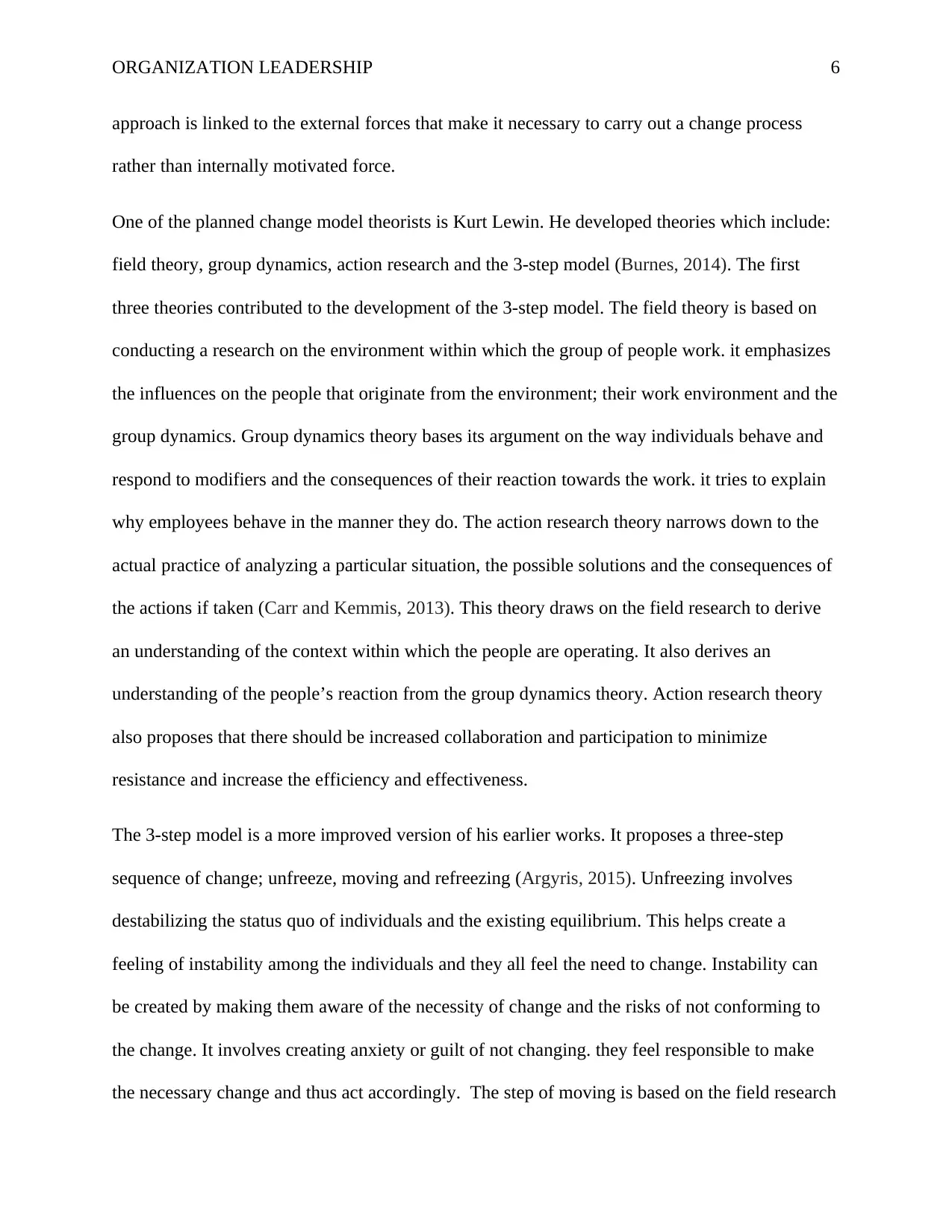
ORGANIZATION LEADERSHIP 6
approach is linked to the external forces that make it necessary to carry out a change process
rather than internally motivated force.
One of the planned change model theorists is Kurt Lewin. He developed theories which include:
field theory, group dynamics, action research and the 3-step model (Burnes, 2014). The first
three theories contributed to the development of the 3-step model. The field theory is based on
conducting a research on the environment within which the group of people work. it emphasizes
the influences on the people that originate from the environment; their work environment and the
group dynamics. Group dynamics theory bases its argument on the way individuals behave and
respond to modifiers and the consequences of their reaction towards the work. it tries to explain
why employees behave in the manner they do. The action research theory narrows down to the
actual practice of analyzing a particular situation, the possible solutions and the consequences of
the actions if taken (Carr and Kemmis, 2013). This theory draws on the field research to derive
an understanding of the context within which the people are operating. It also derives an
understanding of the people’s reaction from the group dynamics theory. Action research theory
also proposes that there should be increased collaboration and participation to minimize
resistance and increase the efficiency and effectiveness.
The 3-step model is a more improved version of his earlier works. It proposes a three-step
sequence of change; unfreeze, moving and refreezing (Argyris, 2015). Unfreezing involves
destabilizing the status quo of individuals and the existing equilibrium. This helps create a
feeling of instability among the individuals and they all feel the need to change. Instability can
be created by making them aware of the necessity of change and the risks of not conforming to
the change. It involves creating anxiety or guilt of not changing. they feel responsible to make
the necessary change and thus act accordingly. The step of moving is based on the field research
approach is linked to the external forces that make it necessary to carry out a change process
rather than internally motivated force.
One of the planned change model theorists is Kurt Lewin. He developed theories which include:
field theory, group dynamics, action research and the 3-step model (Burnes, 2014). The first
three theories contributed to the development of the 3-step model. The field theory is based on
conducting a research on the environment within which the group of people work. it emphasizes
the influences on the people that originate from the environment; their work environment and the
group dynamics. Group dynamics theory bases its argument on the way individuals behave and
respond to modifiers and the consequences of their reaction towards the work. it tries to explain
why employees behave in the manner they do. The action research theory narrows down to the
actual practice of analyzing a particular situation, the possible solutions and the consequences of
the actions if taken (Carr and Kemmis, 2013). This theory draws on the field research to derive
an understanding of the context within which the people are operating. It also derives an
understanding of the people’s reaction from the group dynamics theory. Action research theory
also proposes that there should be increased collaboration and participation to minimize
resistance and increase the efficiency and effectiveness.
The 3-step model is a more improved version of his earlier works. It proposes a three-step
sequence of change; unfreeze, moving and refreezing (Argyris, 2015). Unfreezing involves
destabilizing the status quo of individuals and the existing equilibrium. This helps create a
feeling of instability among the individuals and they all feel the need to change. Instability can
be created by making them aware of the necessity of change and the risks of not conforming to
the change. It involves creating anxiety or guilt of not changing. they feel responsible to make
the necessary change and thus act accordingly. The step of moving is based on the field research
⊘ This is a preview!⊘
Do you want full access?
Subscribe today to unlock all pages.

Trusted by 1+ million students worldwide
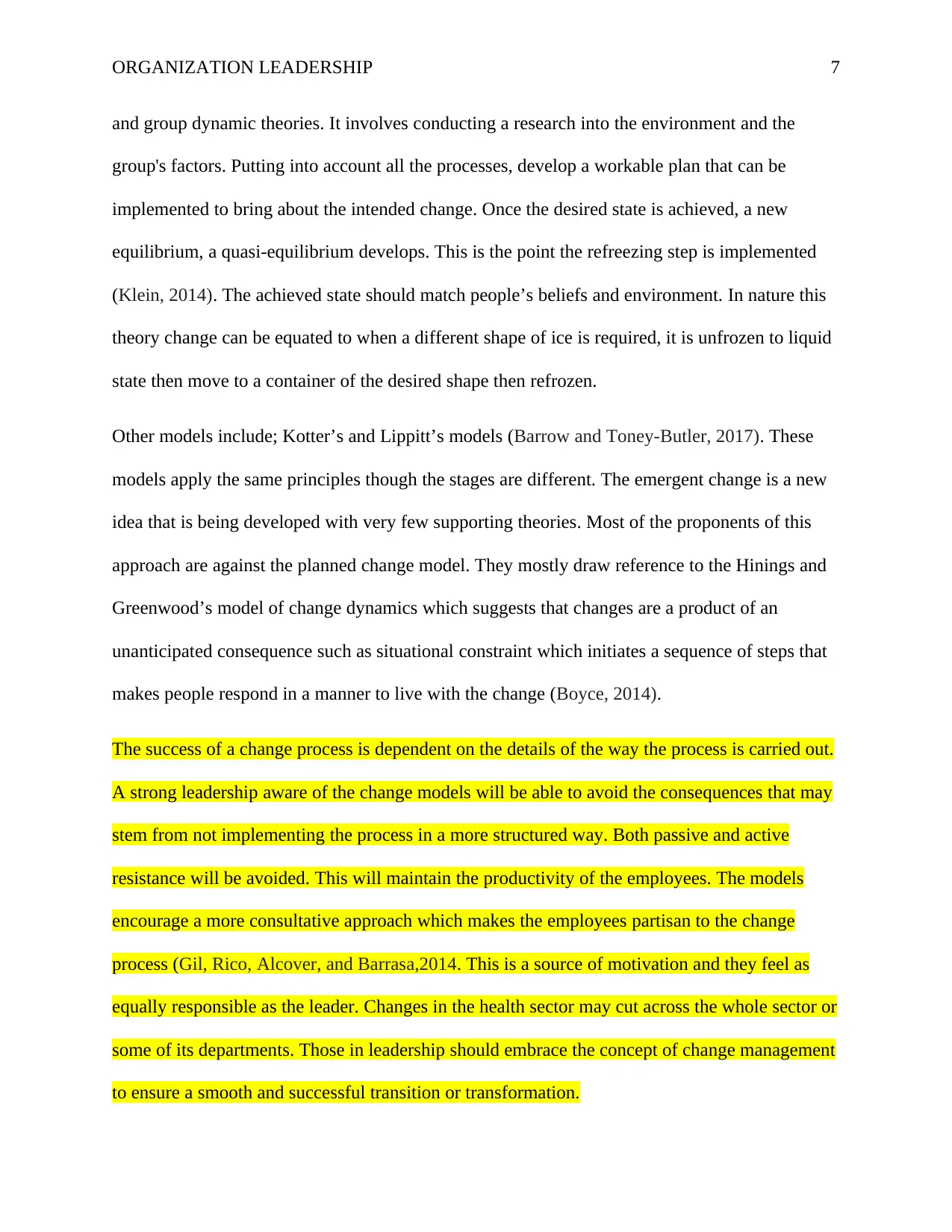
ORGANIZATION LEADERSHIP 7
and group dynamic theories. It involves conducting a research into the environment and the
group's factors. Putting into account all the processes, develop a workable plan that can be
implemented to bring about the intended change. Once the desired state is achieved, a new
equilibrium, a quasi-equilibrium develops. This is the point the refreezing step is implemented
(Klein, 2014). The achieved state should match people’s beliefs and environment. In nature this
theory change can be equated to when a different shape of ice is required, it is unfrozen to liquid
state then move to a container of the desired shape then refrozen.
Other models include; Kotter’s and Lippitt’s models (Barrow and Toney-Butler, 2017). These
models apply the same principles though the stages are different. The emergent change is a new
idea that is being developed with very few supporting theories. Most of the proponents of this
approach are against the planned change model. They mostly draw reference to the Hinings and
Greenwood’s model of change dynamics which suggests that changes are a product of an
unanticipated consequence such as situational constraint which initiates a sequence of steps that
makes people respond in a manner to live with the change (Boyce, 2014).
The success of a change process is dependent on the details of the way the process is carried out.
A strong leadership aware of the change models will be able to avoid the consequences that may
stem from not implementing the process in a more structured way. Both passive and active
resistance will be avoided. This will maintain the productivity of the employees. The models
encourage a more consultative approach which makes the employees partisan to the change
process (Gil, Rico, Alcover, and Barrasa,2014. This is a source of motivation and they feel as
equally responsible as the leader. Changes in the health sector may cut across the whole sector or
some of its departments. Those in leadership should embrace the concept of change management
to ensure a smooth and successful transition or transformation.
and group dynamic theories. It involves conducting a research into the environment and the
group's factors. Putting into account all the processes, develop a workable plan that can be
implemented to bring about the intended change. Once the desired state is achieved, a new
equilibrium, a quasi-equilibrium develops. This is the point the refreezing step is implemented
(Klein, 2014). The achieved state should match people’s beliefs and environment. In nature this
theory change can be equated to when a different shape of ice is required, it is unfrozen to liquid
state then move to a container of the desired shape then refrozen.
Other models include; Kotter’s and Lippitt’s models (Barrow and Toney-Butler, 2017). These
models apply the same principles though the stages are different. The emergent change is a new
idea that is being developed with very few supporting theories. Most of the proponents of this
approach are against the planned change model. They mostly draw reference to the Hinings and
Greenwood’s model of change dynamics which suggests that changes are a product of an
unanticipated consequence such as situational constraint which initiates a sequence of steps that
makes people respond in a manner to live with the change (Boyce, 2014).
The success of a change process is dependent on the details of the way the process is carried out.
A strong leadership aware of the change models will be able to avoid the consequences that may
stem from not implementing the process in a more structured way. Both passive and active
resistance will be avoided. This will maintain the productivity of the employees. The models
encourage a more consultative approach which makes the employees partisan to the change
process (Gil, Rico, Alcover, and Barrasa,2014. This is a source of motivation and they feel as
equally responsible as the leader. Changes in the health sector may cut across the whole sector or
some of its departments. Those in leadership should embrace the concept of change management
to ensure a smooth and successful transition or transformation.
Paraphrase This Document
Need a fresh take? Get an instant paraphrase of this document with our AI Paraphraser
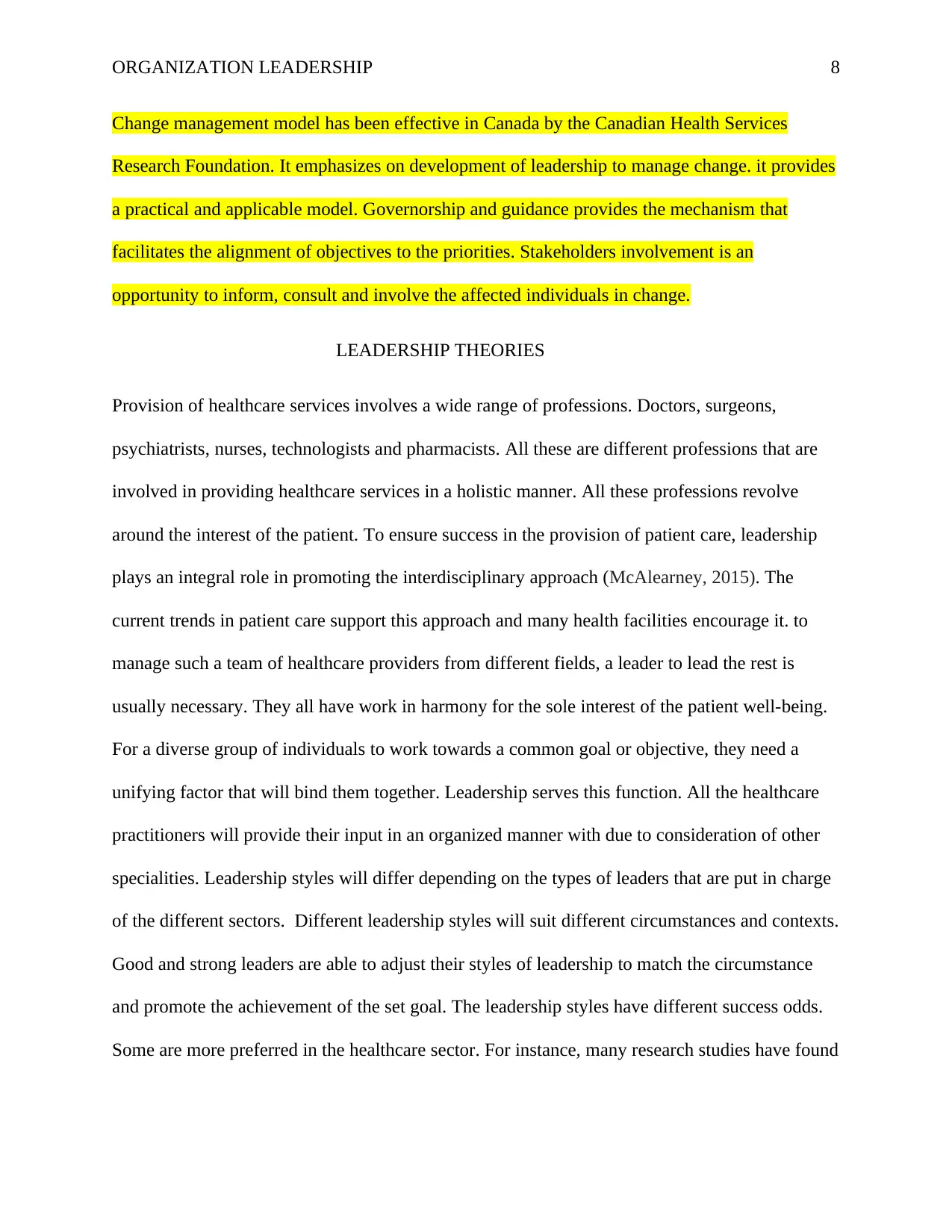
ORGANIZATION LEADERSHIP 8
Change management model has been effective in Canada by the Canadian Health Services
Research Foundation. It emphasizes on development of leadership to manage change. it provides
a practical and applicable model. Governorship and guidance provides the mechanism that
facilitates the alignment of objectives to the priorities. Stakeholders involvement is an
opportunity to inform, consult and involve the affected individuals in change.
LEADERSHIP THEORIES
Provision of healthcare services involves a wide range of professions. Doctors, surgeons,
psychiatrists, nurses, technologists and pharmacists. All these are different professions that are
involved in providing healthcare services in a holistic manner. All these professions revolve
around the interest of the patient. To ensure success in the provision of patient care, leadership
plays an integral role in promoting the interdisciplinary approach (McAlearney, 2015). The
current trends in patient care support this approach and many health facilities encourage it. to
manage such a team of healthcare providers from different fields, a leader to lead the rest is
usually necessary. They all have work in harmony for the sole interest of the patient well-being.
For a diverse group of individuals to work towards a common goal or objective, they need a
unifying factor that will bind them together. Leadership serves this function. All the healthcare
practitioners will provide their input in an organized manner with due to consideration of other
specialities. Leadership styles will differ depending on the types of leaders that are put in charge
of the different sectors. Different leadership styles will suit different circumstances and contexts.
Good and strong leaders are able to adjust their styles of leadership to match the circumstance
and promote the achievement of the set goal. The leadership styles have different success odds.
Some are more preferred in the healthcare sector. For instance, many research studies have found
Change management model has been effective in Canada by the Canadian Health Services
Research Foundation. It emphasizes on development of leadership to manage change. it provides
a practical and applicable model. Governorship and guidance provides the mechanism that
facilitates the alignment of objectives to the priorities. Stakeholders involvement is an
opportunity to inform, consult and involve the affected individuals in change.
LEADERSHIP THEORIES
Provision of healthcare services involves a wide range of professions. Doctors, surgeons,
psychiatrists, nurses, technologists and pharmacists. All these are different professions that are
involved in providing healthcare services in a holistic manner. All these professions revolve
around the interest of the patient. To ensure success in the provision of patient care, leadership
plays an integral role in promoting the interdisciplinary approach (McAlearney, 2015). The
current trends in patient care support this approach and many health facilities encourage it. to
manage such a team of healthcare providers from different fields, a leader to lead the rest is
usually necessary. They all have work in harmony for the sole interest of the patient well-being.
For a diverse group of individuals to work towards a common goal or objective, they need a
unifying factor that will bind them together. Leadership serves this function. All the healthcare
practitioners will provide their input in an organized manner with due to consideration of other
specialities. Leadership styles will differ depending on the types of leaders that are put in charge
of the different sectors. Different leadership styles will suit different circumstances and contexts.
Good and strong leaders are able to adjust their styles of leadership to match the circumstance
and promote the achievement of the set goal. The leadership styles have different success odds.
Some are more preferred in the healthcare sector. For instance, many research studies have found
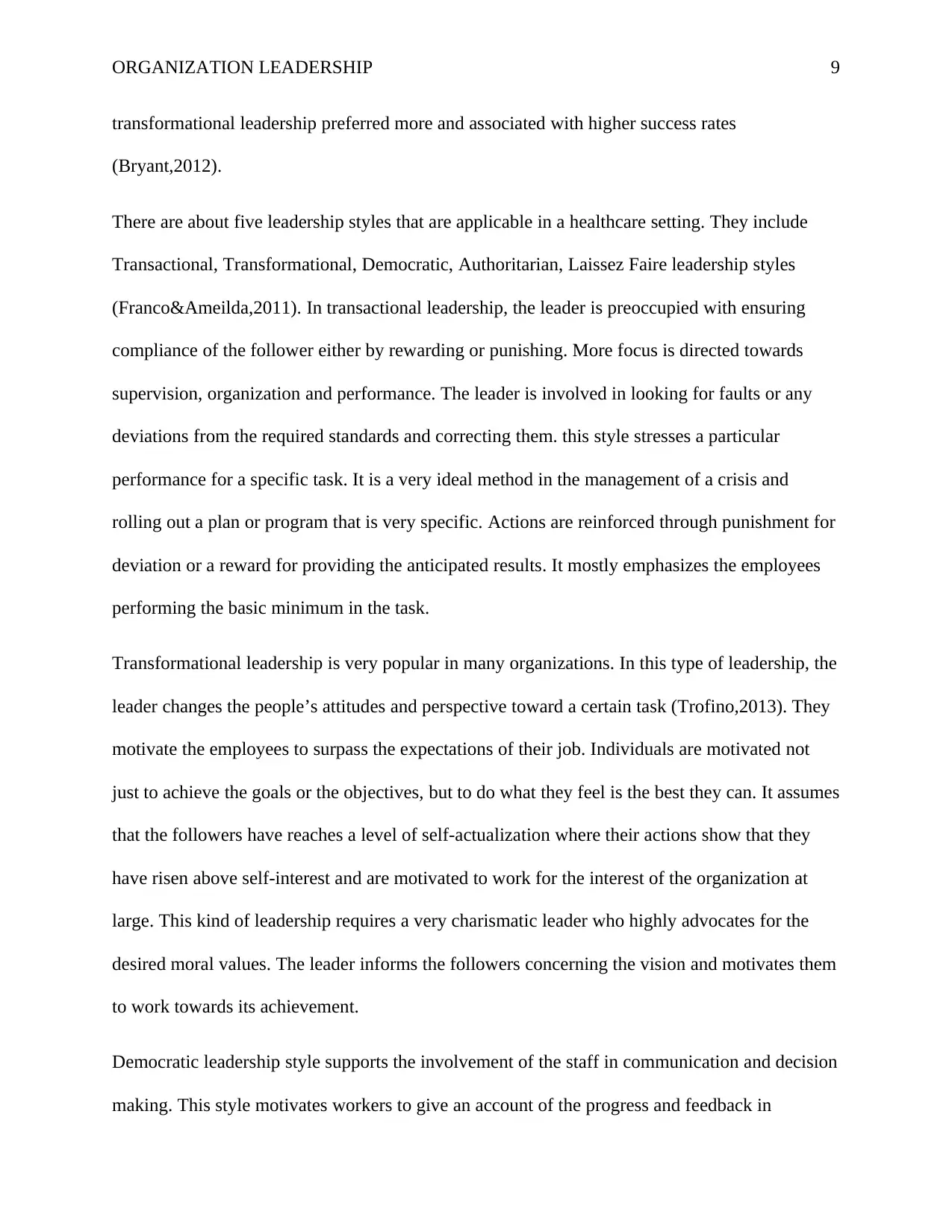
ORGANIZATION LEADERSHIP 9
transformational leadership preferred more and associated with higher success rates
(Bryant,2012).
There are about five leadership styles that are applicable in a healthcare setting. They include
Transactional, Transformational, Democratic, Authoritarian, Laissez Faire leadership styles
(Franco&Ameilda,2011). In transactional leadership, the leader is preoccupied with ensuring
compliance of the follower either by rewarding or punishing. More focus is directed towards
supervision, organization and performance. The leader is involved in looking for faults or any
deviations from the required standards and correcting them. this style stresses a particular
performance for a specific task. It is a very ideal method in the management of a crisis and
rolling out a plan or program that is very specific. Actions are reinforced through punishment for
deviation or a reward for providing the anticipated results. It mostly emphasizes the employees
performing the basic minimum in the task.
Transformational leadership is very popular in many organizations. In this type of leadership, the
leader changes the people’s attitudes and perspective toward a certain task (Trofino,2013). They
motivate the employees to surpass the expectations of their job. Individuals are motivated not
just to achieve the goals or the objectives, but to do what they feel is the best they can. It assumes
that the followers have reaches a level of self-actualization where their actions show that they
have risen above self-interest and are motivated to work for the interest of the organization at
large. This kind of leadership requires a very charismatic leader who highly advocates for the
desired moral values. The leader informs the followers concerning the vision and motivates them
to work towards its achievement.
Democratic leadership style supports the involvement of the staff in communication and decision
making. This style motivates workers to give an account of the progress and feedback in
transformational leadership preferred more and associated with higher success rates
(Bryant,2012).
There are about five leadership styles that are applicable in a healthcare setting. They include
Transactional, Transformational, Democratic, Authoritarian, Laissez Faire leadership styles
(Franco&Ameilda,2011). In transactional leadership, the leader is preoccupied with ensuring
compliance of the follower either by rewarding or punishing. More focus is directed towards
supervision, organization and performance. The leader is involved in looking for faults or any
deviations from the required standards and correcting them. this style stresses a particular
performance for a specific task. It is a very ideal method in the management of a crisis and
rolling out a plan or program that is very specific. Actions are reinforced through punishment for
deviation or a reward for providing the anticipated results. It mostly emphasizes the employees
performing the basic minimum in the task.
Transformational leadership is very popular in many organizations. In this type of leadership, the
leader changes the people’s attitudes and perspective toward a certain task (Trofino,2013). They
motivate the employees to surpass the expectations of their job. Individuals are motivated not
just to achieve the goals or the objectives, but to do what they feel is the best they can. It assumes
that the followers have reaches a level of self-actualization where their actions show that they
have risen above self-interest and are motivated to work for the interest of the organization at
large. This kind of leadership requires a very charismatic leader who highly advocates for the
desired moral values. The leader informs the followers concerning the vision and motivates them
to work towards its achievement.
Democratic leadership style supports the involvement of the staff in communication and decision
making. This style motivates workers to give an account of the progress and feedback in
⊘ This is a preview!⊘
Do you want full access?
Subscribe today to unlock all pages.

Trusted by 1+ million students worldwide
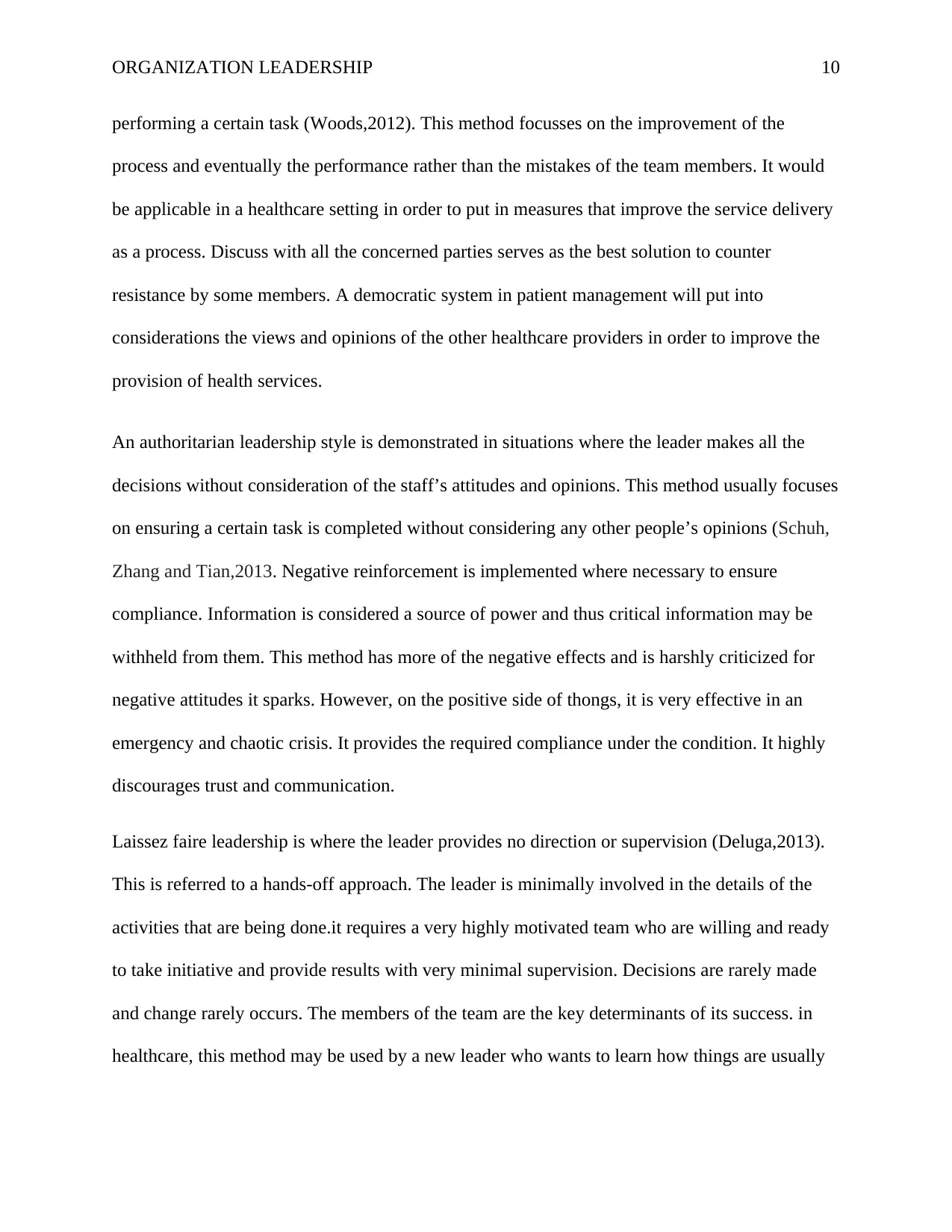
ORGANIZATION LEADERSHIP 10
performing a certain task (Woods,2012). This method focusses on the improvement of the
process and eventually the performance rather than the mistakes of the team members. It would
be applicable in a healthcare setting in order to put in measures that improve the service delivery
as a process. Discuss with all the concerned parties serves as the best solution to counter
resistance by some members. A democratic system in patient management will put into
considerations the views and opinions of the other healthcare providers in order to improve the
provision of health services.
An authoritarian leadership style is demonstrated in situations where the leader makes all the
decisions without consideration of the staff’s attitudes and opinions. This method usually focuses
on ensuring a certain task is completed without considering any other people’s opinions (Schuh,
Zhang and Tian,2013. Negative reinforcement is implemented where necessary to ensure
compliance. Information is considered a source of power and thus critical information may be
withheld from them. This method has more of the negative effects and is harshly criticized for
negative attitudes it sparks. However, on the positive side of thongs, it is very effective in an
emergency and chaotic crisis. It provides the required compliance under the condition. It highly
discourages trust and communication.
Laissez faire leadership is where the leader provides no direction or supervision (Deluga,2013).
This is referred to a hands-off approach. The leader is minimally involved in the details of the
activities that are being done.it requires a very highly motivated team who are willing and ready
to take initiative and provide results with very minimal supervision. Decisions are rarely made
and change rarely occurs. The members of the team are the key determinants of its success. in
healthcare, this method may be used by a new leader who wants to learn how things are usually
performing a certain task (Woods,2012). This method focusses on the improvement of the
process and eventually the performance rather than the mistakes of the team members. It would
be applicable in a healthcare setting in order to put in measures that improve the service delivery
as a process. Discuss with all the concerned parties serves as the best solution to counter
resistance by some members. A democratic system in patient management will put into
considerations the views and opinions of the other healthcare providers in order to improve the
provision of health services.
An authoritarian leadership style is demonstrated in situations where the leader makes all the
decisions without consideration of the staff’s attitudes and opinions. This method usually focuses
on ensuring a certain task is completed without considering any other people’s opinions (Schuh,
Zhang and Tian,2013. Negative reinforcement is implemented where necessary to ensure
compliance. Information is considered a source of power and thus critical information may be
withheld from them. This method has more of the negative effects and is harshly criticized for
negative attitudes it sparks. However, on the positive side of thongs, it is very effective in an
emergency and chaotic crisis. It provides the required compliance under the condition. It highly
discourages trust and communication.
Laissez faire leadership is where the leader provides no direction or supervision (Deluga,2013).
This is referred to a hands-off approach. The leader is minimally involved in the details of the
activities that are being done.it requires a very highly motivated team who are willing and ready
to take initiative and provide results with very minimal supervision. Decisions are rarely made
and change rarely occurs. The members of the team are the key determinants of its success. in
healthcare, this method may be used by a new leader who wants to learn how things are usually
Paraphrase This Document
Need a fresh take? Get an instant paraphrase of this document with our AI Paraphraser
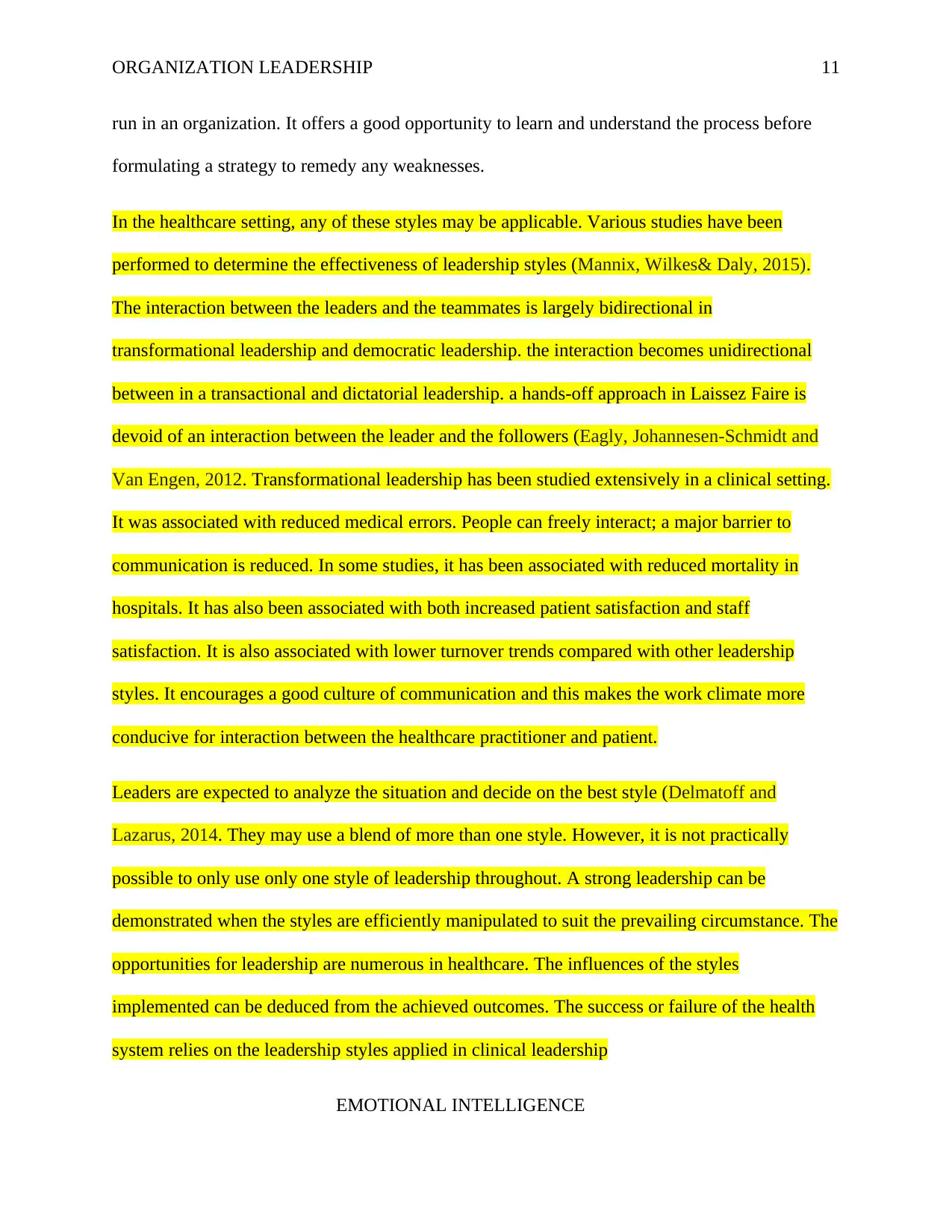
ORGANIZATION LEADERSHIP 11
run in an organization. It offers a good opportunity to learn and understand the process before
formulating a strategy to remedy any weaknesses.
In the healthcare setting, any of these styles may be applicable. Various studies have been
performed to determine the effectiveness of leadership styles (Mannix, Wilkes& Daly, 2015).
The interaction between the leaders and the teammates is largely bidirectional in
transformational leadership and democratic leadership. the interaction becomes unidirectional
between in a transactional and dictatorial leadership. a hands-off approach in Laissez Faire is
devoid of an interaction between the leader and the followers (Eagly, Johannesen-Schmidt and
Van Engen, 2012. Transformational leadership has been studied extensively in a clinical setting.
It was associated with reduced medical errors. People can freely interact; a major barrier to
communication is reduced. In some studies, it has been associated with reduced mortality in
hospitals. It has also been associated with both increased patient satisfaction and staff
satisfaction. It is also associated with lower turnover trends compared with other leadership
styles. It encourages a good culture of communication and this makes the work climate more
conducive for interaction between the healthcare practitioner and patient.
Leaders are expected to analyze the situation and decide on the best style (Delmatoff and
Lazarus, 2014. They may use a blend of more than one style. However, it is not practically
possible to only use only one style of leadership throughout. A strong leadership can be
demonstrated when the styles are efficiently manipulated to suit the prevailing circumstance. The
opportunities for leadership are numerous in healthcare. The influences of the styles
implemented can be deduced from the achieved outcomes. The success or failure of the health
system relies on the leadership styles applied in clinical leadership
EMOTIONAL INTELLIGENCE
run in an organization. It offers a good opportunity to learn and understand the process before
formulating a strategy to remedy any weaknesses.
In the healthcare setting, any of these styles may be applicable. Various studies have been
performed to determine the effectiveness of leadership styles (Mannix, Wilkes& Daly, 2015).
The interaction between the leaders and the teammates is largely bidirectional in
transformational leadership and democratic leadership. the interaction becomes unidirectional
between in a transactional and dictatorial leadership. a hands-off approach in Laissez Faire is
devoid of an interaction between the leader and the followers (Eagly, Johannesen-Schmidt and
Van Engen, 2012. Transformational leadership has been studied extensively in a clinical setting.
It was associated with reduced medical errors. People can freely interact; a major barrier to
communication is reduced. In some studies, it has been associated with reduced mortality in
hospitals. It has also been associated with both increased patient satisfaction and staff
satisfaction. It is also associated with lower turnover trends compared with other leadership
styles. It encourages a good culture of communication and this makes the work climate more
conducive for interaction between the healthcare practitioner and patient.
Leaders are expected to analyze the situation and decide on the best style (Delmatoff and
Lazarus, 2014. They may use a blend of more than one style. However, it is not practically
possible to only use only one style of leadership throughout. A strong leadership can be
demonstrated when the styles are efficiently manipulated to suit the prevailing circumstance. The
opportunities for leadership are numerous in healthcare. The influences of the styles
implemented can be deduced from the achieved outcomes. The success or failure of the health
system relies on the leadership styles applied in clinical leadership
EMOTIONAL INTELLIGENCE
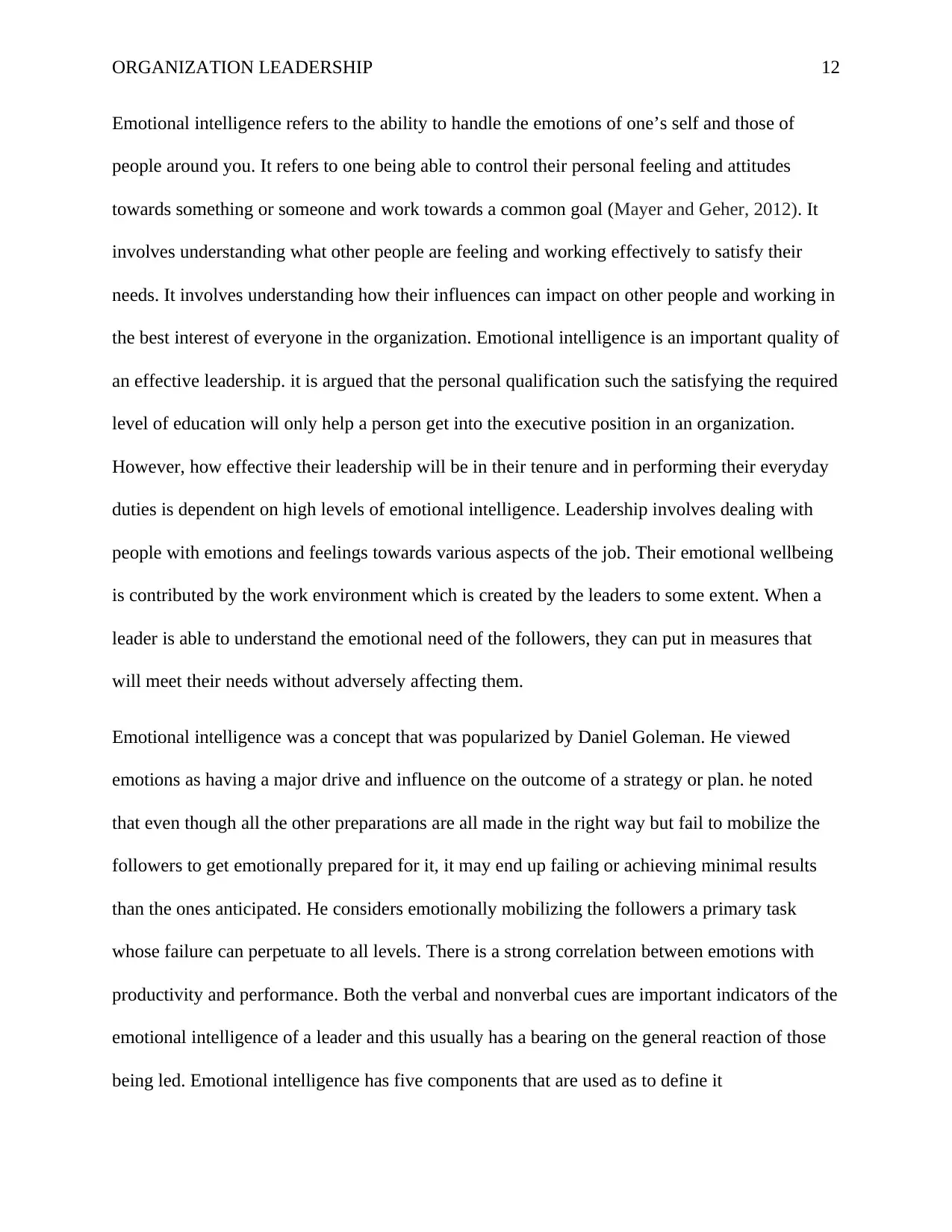
ORGANIZATION LEADERSHIP 12
Emotional intelligence refers to the ability to handle the emotions of one’s self and those of
people around you. It refers to one being able to control their personal feeling and attitudes
towards something or someone and work towards a common goal (Mayer and Geher, 2012). It
involves understanding what other people are feeling and working effectively to satisfy their
needs. It involves understanding how their influences can impact on other people and working in
the best interest of everyone in the organization. Emotional intelligence is an important quality of
an effective leadership. it is argued that the personal qualification such the satisfying the required
level of education will only help a person get into the executive position in an organization.
However, how effective their leadership will be in their tenure and in performing their everyday
duties is dependent on high levels of emotional intelligence. Leadership involves dealing with
people with emotions and feelings towards various aspects of the job. Their emotional wellbeing
is contributed by the work environment which is created by the leaders to some extent. When a
leader is able to understand the emotional need of the followers, they can put in measures that
will meet their needs without adversely affecting them.
Emotional intelligence was a concept that was popularized by Daniel Goleman. He viewed
emotions as having a major drive and influence on the outcome of a strategy or plan. he noted
that even though all the other preparations are all made in the right way but fail to mobilize the
followers to get emotionally prepared for it, it may end up failing or achieving minimal results
than the ones anticipated. He considers emotionally mobilizing the followers a primary task
whose failure can perpetuate to all levels. There is a strong correlation between emotions with
productivity and performance. Both the verbal and nonverbal cues are important indicators of the
emotional intelligence of a leader and this usually has a bearing on the general reaction of those
being led. Emotional intelligence has five components that are used as to define it
Emotional intelligence refers to the ability to handle the emotions of one’s self and those of
people around you. It refers to one being able to control their personal feeling and attitudes
towards something or someone and work towards a common goal (Mayer and Geher, 2012). It
involves understanding what other people are feeling and working effectively to satisfy their
needs. It involves understanding how their influences can impact on other people and working in
the best interest of everyone in the organization. Emotional intelligence is an important quality of
an effective leadership. it is argued that the personal qualification such the satisfying the required
level of education will only help a person get into the executive position in an organization.
However, how effective their leadership will be in their tenure and in performing their everyday
duties is dependent on high levels of emotional intelligence. Leadership involves dealing with
people with emotions and feelings towards various aspects of the job. Their emotional wellbeing
is contributed by the work environment which is created by the leaders to some extent. When a
leader is able to understand the emotional need of the followers, they can put in measures that
will meet their needs without adversely affecting them.
Emotional intelligence was a concept that was popularized by Daniel Goleman. He viewed
emotions as having a major drive and influence on the outcome of a strategy or plan. he noted
that even though all the other preparations are all made in the right way but fail to mobilize the
followers to get emotionally prepared for it, it may end up failing or achieving minimal results
than the ones anticipated. He considers emotionally mobilizing the followers a primary task
whose failure can perpetuate to all levels. There is a strong correlation between emotions with
productivity and performance. Both the verbal and nonverbal cues are important indicators of the
emotional intelligence of a leader and this usually has a bearing on the general reaction of those
being led. Emotional intelligence has five components that are used as to define it
⊘ This is a preview!⊘
Do you want full access?
Subscribe today to unlock all pages.

Trusted by 1+ million students worldwide
1 out of 21
Related Documents
Your All-in-One AI-Powered Toolkit for Academic Success.
+13062052269
info@desklib.com
Available 24*7 on WhatsApp / Email
![[object Object]](/_next/static/media/star-bottom.7253800d.svg)
Unlock your academic potential
Copyright © 2020–2025 A2Z Services. All Rights Reserved. Developed and managed by ZUCOL.





